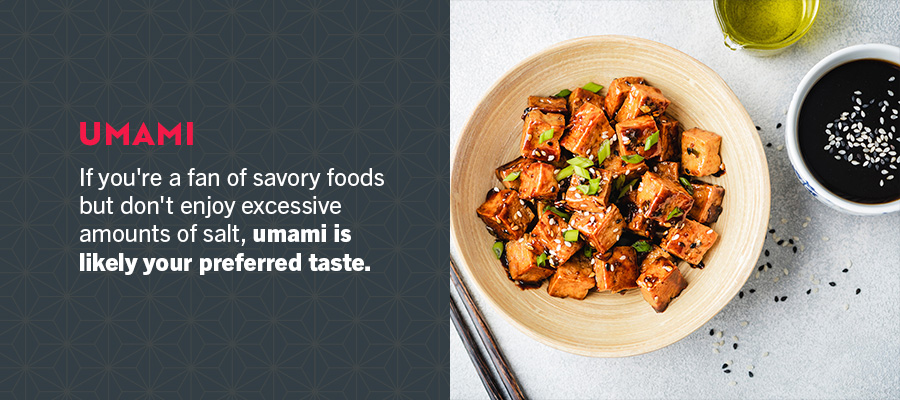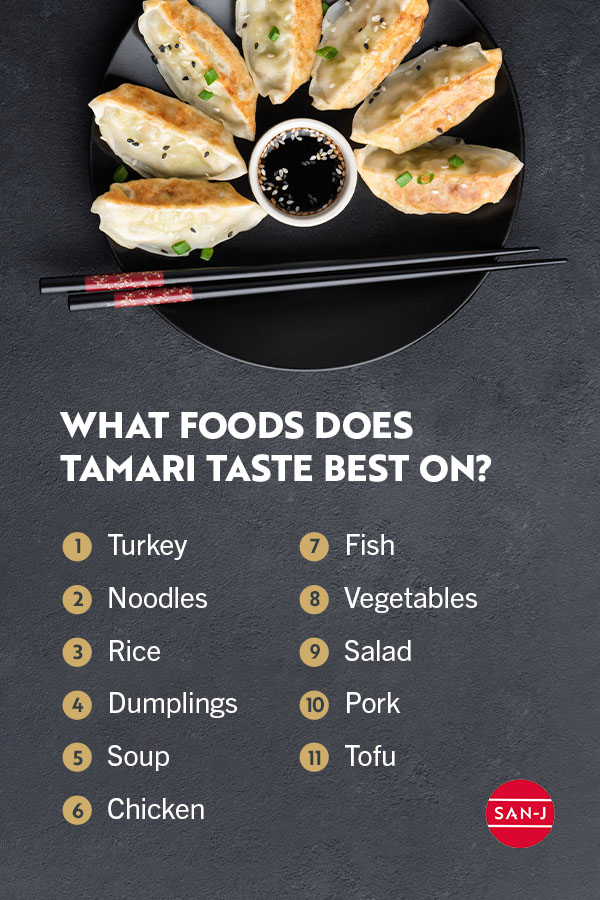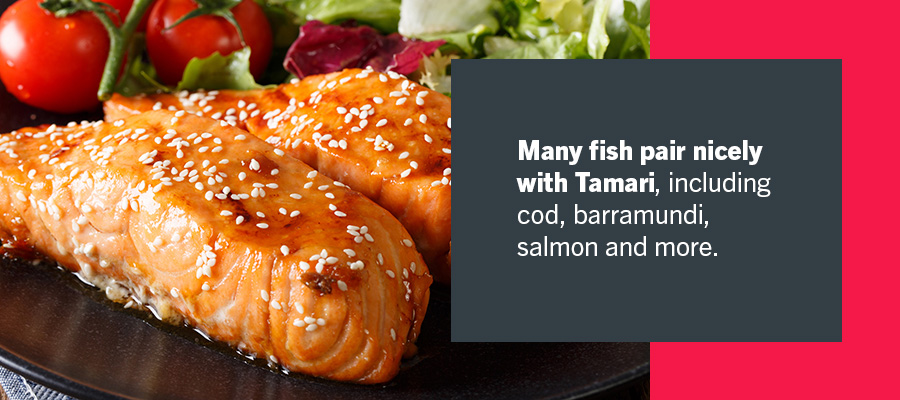If you’re searching for a way to spruce up a savory dish such as meat, fish, pasta or vegetables, Tamari may be just the condiment you’re looking for. If you’re unfamiliar with Tamari or have never tasted it before, we’re here to provide you with all the information you need to understand the true significance of its remarkable flavor.
Read this complete guide to learn about the distinctive taste profiles of Tamari, a brief history and some different foods to pair it with. We’ll also cover some fascinating history and properties of umami, a rich and savory taste commonly identified in Tamari. Let’s dive in!
Table of Contents
What Is Tamari?
What Does Tamari Taste Like?
What Is Umami?
Properties of Umami
What Foods Does Tamari Taste Best On?
Get Tamari From San-J Today
What Is Tamari Sauce?
Tamari sauce is a type of Japanese soy sauce. Compared to typical soy sauces, this condiment has a richer and milder taste. The main difference between tamari and typical soy sauce is ingredient ratio. While typical soy sauce is made with about half soybeans and half wheat, tamari is made with soybeans and contains little to no wheat. Despite of a richer taste and a darker color, tamari and typical soy sauces have about the same amount of sodium. Try reduced-sodium options) if you are looking for a way to reduce your sodium intake.
A Brief History of Tamari
The history of Tamari dates back to the seventh century AD when it was initially brought from China to Japan. It was discovered that cooking and fermenting soybeans produces a dark red paste, which the Japanese named “miso.” The ripening process of miso produced a protein-rich liquid later dubbed “Tamari.” This name translates to “that which accumulates.” This product marks the origin of Japanese soy sauce.
What Does Tamari Taste Like?
Despite tasting more mellow than most soy sauces, Tamari’s high soybean concentration gives it a deep, rich umami flavor. Tamari sauce adds a smooth, savory and almost meaty taste to essentially any dish it accompanies.
Tamari is commonly paired with soups, noodles, dumplings, rice, and other Japanese dishes to enhance their flavor, adding just the right amount of salt and texture. To give your meal a deeper, more exciting blend of flavor, consider adding some Tamari Soy Sauce!
What Is Umami?
Umami is the perfect way to describe Tamari — it’s a meaty, savory flavor that comforts the taste buds. It typically describes various meats, fish, broths, gravies, cheeses and vegetables. If you’re a fan of savory foods but don’t enjoy excessive amounts of salt, umami is likely your preferred taste.

A Brief History of Umami
You’re likely familiar with the four basic taste groups — sweet, sour, salty and bitter. However, a fifth identified taste was added to the mix in the mid-1980s. Professor Kikunae Ikeda first discovered this distinctive savory flavor in the early 19th century when tasting boiled tofu in kombu dashi, a kelp-based broth.
This taste was eventually given the name umami, a Japanese term that translates to “deliciousness” or “pleasant savory taste.” Umami is often present in foods that contain the amino acid, glutamate, such as parmesan cheese, mushrooms, miso and seaweed.
Umami was officially chosen as the name for this fifth taste in Hawaii in 1985 at the Umami International Symposium. For umami to become an independent taste, researchers had to prove it was not a combination of other tastes and used its own taste receptor. Since their success, umami has become a widely popular flavor with food manufacturers, especially those seeking lower-sodium alternatives.
Properties of Umami
Umami taste has various properties that distinguish it from the other four taste groups. Now that we’ve covered a brief history of umami, let’s look at some significant characteristics that highlight the essence of this unique and delicious taste:
- Long-lasting flavor: Many have described umami as having a mild but lasting aftertaste that spreads across the tongue and throat and roof and back of the mouth. Though it may not be ideal as a standalone taste, it complements numerous other foods wonderfully.
- Varied foods: We may not always realize it, but umami flavor is in foods we eat every day. Glutamate is present in multiple foods, including cheese, meat, vegetables and even green tea!
- Easily achievable: This delicious flavor is surprisingly easy to achieve when cooking. Glutamate is in many condiments that may be sitting in your pantry — salad dressings, ketchup, soy sauce, miso, truffle oil and more.
- Savory and mouthwatering: Umami provides a savory, mouthwatering sensation — this is probably its most significant identifying factor.
- Effective food enhancer: Umami’s savory quality can round out contrasting flavors, making them taste even better.
- Less sodium intake: Use umami rich condiment such as tamari in place of salt to reduce sodium.
What Foods Does Tamari Taste Best On?

Tamari complements many savory dishes to create a delicious, balanced blend of flavor. If you’re looking for different foods to try with Tamari, here are 11 meals you might consider pairing this sauce with:
1. Turkey
To create the perfect comfort meal, try brining your turkey with Tamari. This is a great way to prevent the bird from toughening or drying out, as the salt and water mixture allows the turkey to absorb moisture. Refrigerate your Tamari-brined turkey to use for sandwiches and future meals, or wow your family and friends on Thanksgiving!
Try out this mouthwatering honey soy glazed turkey for another great turkey recipe. This recipe will surely satisfy. It has a diverse blend of flavors that includes sweet honey and molasses, red pepper flakes, garlic powder, tender turkey and plenty of Tamari Soy Sauce.
2. Noodles
If you’re a diehard pasta fan, Tamari adds an extra delectable taste to various noodles. Consider tossing ramen, udon or soba noodles with Tamari to create a rich and irresistible flavor!
Try out this Thai noodles with spring vegetables recipe if you’re looking for a tasty way to add Tamari to your noodles. This dish is perfect for a delicious meal. It creates a flavorful blend of gluten-free Pad Thai noodles and Tamari Soy Sauce, along with other veggies and seasonings. Top it with some sesame seeds for extra garnish.
3. Rice
You can also add extra flavor to an ordinary bowl of rice by mixing it with some Tamari Soy Sauce! Whether steamed or fried, rice is a great dish to pair with this tasty condiment. For a delicious meal that blends steamed Japanese rice with Tamari, try out this Oyako Donburi recipe — chicken and egg with rice. Pick up some boneless chicken breasts, onion, mushrooms, vegetable oil, rice and Tamari Soy Sauce, and cook up this dish for your next meal.
4. Dumplings
Tamari is an excellent dipping sauce for dumplings. Mix Tamari, rice vinegar, and toasted sesame oil. Add some chili oil if you like it spicy. It also pairs wonderfully with potstickers, a type of Chinese dumpling that’s steamed on one side and pan-fried on the other. If you’re having homemade Chinese food, consider adding lamb potstickers to your spread. This dish calls for a pound of lean ground lamb, fresh ginger and onion, a large egg and some Tamari Soy Sauce. With this delicious recipe, you’ll likely find it impossible to eat just one.
5. Soup
A steaming, savory bowl of soup is the perfect meal for a chilly day. However, it can taste even better when you add some Tamari to your broth. Consider trying this easy Asian noodle soup recipe. This dish is simple and fun to make, and it only takes minutes. All you’ll need is some chicken broth, mushrooms, onions, seaweed, thin rice noodles and 3 tablespoons of Tamari. Give this soup recipe a go for your next meal!
For a more veggie-based soup, you can try out this creamy miso broccoli soup. This hot, delicious dish creates a savory blend of fresh chopped broccoli, peas, onion, white beans, garlic, Tamari Soy Sauce and other umami ingredients. You’ll likely find yourself making this soup over and over again after just one taste!
6. Chicken
Chicken is a versatile meal. You can cook and prepare it in multiple ways — fried, grilled, baked, roasted and more. You can also use a range of seasonings and flavorings — one of them being Tamari Soy Sauce.
There are endless options for chicken dishes you can pair Tamari with. If you need some inspiration, try this delicious honey and Tamari chicken recipe! This dish creates a delightful blend of savory, tender chicken with the sweet taste of clover honey while adding some fresh veggies, spices and rice.
If you’re looking for another chicken and Tamari-based dish, this slow cooker Asian sesame chicken will make your mouth water. With just the right combination of chicken, apple cider vinegar, sesame oil and Tamari Soy Sauce, dinnertime will surely be a delight.
7. Fish
If you enjoy seafood, consider enhancing the flavor of your fish with some Tamari. Many fish pair nicely with Tamari, including cod, barramundi, salmon and more. This halibut with white wine, Tamari and lemon recipe is the perfect concoction of flavors — tangy citrus, tender halibut fillets, dry white wine and fresh, thinly-sliced vegetables.
For another delicious fish recipe, try out these coconut fish sticks! If you love the taste of sweet coconut and seafood, this recipe captures both of these flavors perfectly. All you’ll need is some tilapia fillets, coconut flakes, mayonnaise, a teaspoon of Tamari Soy Sauce and one large egg to whip up these fish sticks. These are ideal appetizers to accompany your next meal and are delightful to eat on their own — give them a try!

8. Vegetables
Cooked vegetables are a delicious, healthy meal with an array of possibilities for garnishes, seasonings and flavorings. Tamari Soy Sauce is an excellent condiment to add to your veggies for a boost of flavor.
For a fun, easy vegetable recipe, try out these grilled vegetable skewers. These are perfect for warmer seasons, as you can cook them outside on the grill. Consider serving these as a dinner appetizer for your next summer cookout. Pick up some fresh vegetables, wooden skewers, spices and Tamari and try these out!
This spicy beef and vegetable stir fry is another great way to combine cooked vegetables and Tamari for a mouthwatering flavor. This recipe will likely become a favorite with its unique blend of sweet brown sugar, spicy ginger, chili garlic paste and plenty of fresh vegetables.
9. Salad
Though salad is a simple side dish to serve alongside your entrée, it’s delicious when paired with the right blend of condiments, toppings, garnishes or dressings. Try making this crisp chicken curry salad for a great way to pair Tamari Soy Sauce with your salad. This recipe integrates a balanced blend of tender chicken breast, curry powder and cayenne pepper, red lettuce leaves, fresh veggies and more.
You also might consider tossing up some roasted spring vegetable cobb salad. With the perfect combination of garbanzo beans, sweet honey, apple cider vinegar, Tamari and fresh arugula and veggies, this salad is ideal for enjoying on a warm summer afternoon.
10. Pork
Pork is another delicious meat to pair with Tamari for an extra savory and mouthwatering flavor. Try cooking up some hoisin pork stir fry in a large frying pan or wok for a tasty pork and Tamari recipe. All you’ll need is a pound of pork tenderloin, some grapeseed oil, snow peas, sliced bamboo shoots and Tamari hoisin sauce. Your next dinner entrée will surely be a hit with this irresistible dish.
Additionally, try this delicious Japanese ginger pork, or Shoga-Yaki! With this recipe, season pork with potato starch, vegetable oil and sake, then top with a rich ginger sauce containing Tamari for an ideal blend of sweet and savory flavors.
11. Tofu
If you’re looking for a healthier meat substitute to lower your cholesterol and provide an excellent source of iron, you might consider pairing some Tamari with tofu for your next meal. Try this Tamari tofu recipe if you need a simple, tasty dish to cook. Pick up a package of tofu, some grapeseed oil and a generous amount of Tamari Soy Sauce. You can also add any desired seasonings such as onion, garlic powder, cumin or red pepper flakes.
Get Tamari From San-J Today

After you’ve read about the origins and flavor properties of Tamari and umami, we hope you’re inspired to try pairing some Tamari with your next meal. These delicious dishes all incorporate the irresistible savory taste of Tamari to create meals that will last in your memories.
At San-J, we offer a wide selection of quality, fresh and delicious Tamari Soy Sauce products. Our Tamari is carefully brewed and fermented for up to six months for a rich, authentic flavor. Our sauces contain no artificial flavors, colors or preservatives. They are also Non-GMO verified by the Non-GMO Project and certified gluten-free by the Gluten-Free Certification Organization. We also provide lower-sodium Tamari options for those looking to reduce their salt intake. No matter your dietary needs or preferences, we have products for everyone to enjoy.
To purchase your San-J Tamari, you can order it online or locate a store near you. Get yours today!
Back to Top

